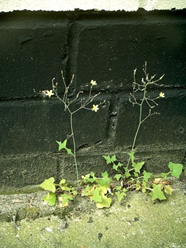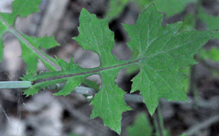Wall Lettuce
(Mycelis muralis (L.) Dumort.)
Family: Aster family (Asteraceae)
Native Range: Southern Europe, West Asia

Overview: Slender annual or biennial herbaceous plant with smooth erect stems.
Size: 2-3ft tall
Leaves: At the base of the stems, alternate leaves have deep, pointed lobes and a large triangular lobe at the end. Basal leaves are 2 ½ –7 inches long and 1–3 inches wide rosette; the few leaves that grow higher on the stems are smaller. Foliage turns yellow in autumn.
Stem/Bark: 2–3 feet tall and branch near the top; when broken, they exude a milky fluid that can irritate the skin
Flowers: Small, light yellow flowers form in June on the widely spaced stems. Each flower head is composed of 5 narrow rays; the blunt ends of the rays have 5 small teeth.
Seed/Fruit: Small achenes with prominent veins; each achene has a tuft of long, white, bristly hairs.
Roots: fibrous
Reproduction: Self-fertilizing, produces a great quantity of seeds and depends on wind dispersal —in a sunny area, a single plant may produce more than 10,000 seeds. The tufts of hairs attached to the fruits act as parachutes that allow them to float on the wind, dispersing the seeds over long distances. Plants do not reproduce vegetatively.
Ecological Threat
Wall lettuce quickly invades many habitats, where it may displace native species. Because it produces so many seeds, wall lettuce can quickly take over an area, carpeting the ground in just a few seasons. It can be especially invasive in forests and wetlands with rich, moist soils.
Distribution and Background
Native to southern Europe and western Asia, wall lettuce is invasive in Alaska and the Pacific Northwest. It has been found from eastern Canada south to New York and west to Minnesota. In New England, it is currently mapped in Maine, Massachusetts, New Hampshire, and Vermont.
Habitat Type
Wall lettuce can grow in either deep shade or full sun and in a wide range of soil conditions; it is tolerant of drought and frost.
Management Options
Biological Control
- None currently available.
Manual Control
- hand pulling; grip plant close to the ground and pull up ensuring to remove all parts of the fibrous root.
Mechanical Control
Chemical Control
Notice: Mention of Pesticide Products On This Web Site Does Not Constitute Endorsement Of Any Material. See Control and Disposal Methods for descriptions of application types and warnings.
Disposal
- If pulled before having gone to see, it is safe to shred plant and compost on site.
- If seeds persist, bag pulled plant in full.
Look-alikes
 A key feature of wall lettuce that helps to distinguish it from other yellow-flowered plants in the aster family (such as dandelion, the hawkweeds, sow-thistles, and other wild lettuces) are the five-rayed flowers. Similar-looking species have many more rays. The leaves of wall lettuce are also distinctive, with a large triangular lobe at the end and bases that clasp the stem.
A key feature of wall lettuce that helps to distinguish it from other yellow-flowered plants in the aster family (such as dandelion, the hawkweeds, sow-thistles, and other wild lettuces) are the five-rayed flowers. Similar-looking species have many more rays. The leaves of wall lettuce are also distinctive, with a large triangular lobe at the end and bases that clasp the stem.